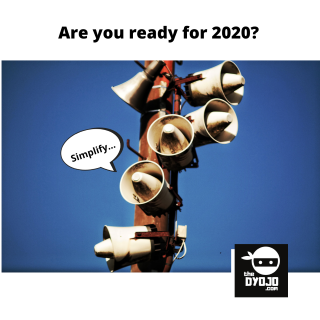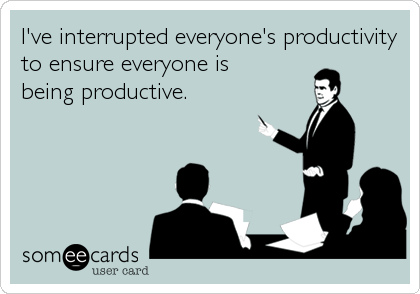Build momentum toward reaching your goals by simplifying your vision process. How many times have you been asked, “Where do you see yourself in five years?” While it seems like a silly question when you are applying for an entry level job flipping burgers, or any job for that matter, it is one that can be helpful for your personal development. Where do you want to be in five years? Do you have a vision for your professional life trajectory? Hellen Keller was born both deaf and blind but refused to allow those major setbacks to define her. Her words and example are an inspiration as well as a kick in the butt when she says, “The only thing worse than being blind is having sight but no vision.” Start with what isn’t. If it isn’t enough that 2020 is trying to slap you in the face, you’ve just been called out by Hellen Keller. Before you despair, let us help you simplify your pursuit of a clear vision by ruling out those items that are not critical to being purpose driven. Having vision is not about seeing the future. You are not required to be a fortune teller or a practicing daytime television psychic in order to have vision for your future. We are enamored with the false idea that only the special can thrive. Do not buy into the concept that in order to be an effective leader you have to also be a seer of the unknown. Do you heap pressures upon yourself by believing it is your job to think about what will change in the coming year so that you can seize upon those opportunities? By contrast, Amazon CEO Jeff Bezos finds it helpful to ask, “What won’t change.” He knows that customers will always want lower prices, wider selection and faster delivery. These expectations are a constant. Jeff knows he will never have a customer come to him and say, "Jeff, I love Amazon; I just wish the prices were a little higher. I love Amazon; I just wish you'd deliver a little more slowly."
Change is a constant, adapt. While it serves purpose well to ask yourself, what won’t change as opposed to worrying about what will change, this does not mean that we aren’t required to adapt. Jack Welch is viewed by many as the key figure in General Electric’s reportedly 4,000% growth during his tenure as CEO from 1981-2001. He speaks often on the importance of leaders creating clarity in vision, structuring the processes around purpose and seeing things through to completion. Two decades of sustained growth, leading teams through transitions from the 80’s to the 90’s and then into the new century, makes for some unique perspectives on growth. Vision must be revisited regularly as the market evolves. As a leader you must lead yourself before you can lead your team as both you and the organization have to be prepared to adapt regularly. Even in a company as large as GE, Jack Welch understood the importance of continual growth, “If the rate of change on the outside exceeds the rate of change on the inside, the end is near.” Finding the means to clarify your vision in the midst of uncertainty is essential. Build upon a sense of purpose for yourself and help your team members to grasp theirs.
Eliminate the unsuccessful. We have bought into the belief that in order to be prosperous we need to emulate the habits of the uber successful. Author Darius Foroux talks about meeting a wealthy (aka “successful”) person for the first time. In sharing this, Darius counters the idea of copying the rich, as the entrepreneur told him, “I just try to avoid being unsuccessful. Study what makes you unsuccessful, unhappy, broke, fat, stupid. Then, eliminate those things out of your life.” Simple but never easy. Turn your sights towards reducing wasted energy and transfer that to productive outputs. It is important to establish your own purpose and to define your own goals. Your definition of success may be different from the next person, and it should be. If Jeff Bezos leads Amazon by asking, “What isn’t going to change,” you will also find value in asking yourself, “What have I been doing that is not bringing me closer to my vision and goals?” It takes time to develop broken thought patterns and bad habits, so it will also take time to create new routines. Recognizing the need to change is the first step in pursuing positive changes.
Simplify and make progress in the process. With so much information at our disposal, it is important to remember that mastering the basics and building from that foundation is still a solid course towards growth. Bruce Lee had some great comments in this regard, “It is not a daily increase, but a daily decrease. Hack away at the inessentials.” This imagery is excellent, we are in a fight to literally “hack away” those things which steal our focus and energy from gaining momentum in our pathway to success. You have limited time and energy, if you can direct those resources at useful endeavors you will win.
The key is to STOP doing what isn’t working. With these perspectives you can start to simplify the path towards conquering your growth goals. Author and coach, Lex Sisney, recaps an effective strategy for coaching your employees that is apropo to leading oneself—the Stop-Start-Ideal approach. Lex says, “If we can first get clear on what old behaviors or mindsets need to stop, and actually stop them, by law that frees up energy and capacity to develop new mindsets and behaviors. If we don’t first stop the old behaviors, the inertia of the status quo will continue.” We are all too familiar with the allure and the consequences of the status quo. 2020 is a great year to operate from a place of clarity as we make progress in the process.
0 Comments
 Sounds about right Sounds about right To be productive one has to first produce and secondly to produce productively. Productivity is rather simple and in the pursuit of enhancing productivity perhaps therein lies the key to success – keeping things simple. What are we producing and are we producing it efficiently? It may not be that surprising to discover than many companies are not that clear on what their core offering is. In the business world there are goods and there are services and there are companies that do both, but those two components are the primary mode of value for any entity in the marketplace. Those organizations that know what their value offering is and how to position that value are the companies that have the best opportunity (nothing is guaranteed) to operate as a viable business. The primary obstacle for any individual who seeks to start a business is to make the decision to go for it. Put another way, the primary step in starting is simply starting. When a person has identified a good or service that they can bring to the marketplace with value, they must first overcome their own fear of failure (atychiphobia). This applies to starting anything, whether it’s a new business, a new direction or a new discipline within an existing organization. Productivity requires vision. “There are risks and costs to action. But they are far less than the long range risks of comfortable inaction.” – John F. Kennedy, former U.S. President Everything has a consequence, those who are looking to start something or make a change need to find the confidence to move forward with what their vision and values are telling them to do. Having vision is of great value, when an individual sees a need for change the next step is to put some thought, action and endurance into motion to see that thing through. Productivity requires movement. Efficiency is a measure the ability to produce something in relationship to the output of resources utilized. Resources include raw materials, capital and labor. For so many that make the leap to start their own business, they think, “If I was making $20 per hour and now I am making $30 per hour as a business owner, I am really making it.” What they don’t take into account is that they are self-employed and paying themselves $30 an hour but if that is also all they are charging then they are setting nothing aside for overhead costs such as vehicle maintenance, office supplies, utilities, taxes and etc. Productivity requires data. “If your business depends on you, you don't own a business-you have a job. And it's the worst job in the world because you're working for a lunatic...You can't close it when you want to, because if it's closed you don't get paid. You can't leave it when you want to, because if you leave there's nobody there to do the work. You can't sell it when you want to, because who wants to buy a job?” —Michael Gerber, author of E-Myth Productivity has to do with being efficient with your resources while providing your product or service. Being able to measure productivity involves knowing your production costs, the adage that the numbers don’t lie is true as long as you track your numbers accurately and allow them to speak for themselves without manipulation. If you seek to be productive the first steps involve finding a means to track your costs such as labor, materials, overhead costs and profitability goals. Productivity requires listening. (Video on listening HERE) While the point of this article is not to be a deep expose into the intricacies of cost analysis in relationship to productivity goals, it is important to note that they only way to track productivity is first to be tracking something. A simple excel spreadsheet can assist to track time and materials applied to a project. Start by tracking expenditures and revenue daily and where there are spikes in either dig into where those inconsistencies are coming from. Allow the numbers to show you what is and what isn’t working, or to at least understand the expenditure of resources going into pursuing your vision. Productivity requires tracking. “I never lie because I don’t fear anyone. You only lie when you’re afraid.” – John Gotti, crime boss Failure to launch is rooted in the fear of failure. We stop ourselves short of putting our vision into motion because we undervalue our ability to create value, rise above obstacles and adapt as we receive new information along the way. Failure to improve is rooted in the same fear of failure (more HERE). Often we deceive ourselves into thinking things are working because of tradition, ie this is how things have always been done and so it’s safe to continue swimming with the stream, or because of blind commitment to a system of productivity that has handed down to us, where there is less resistance by simply keeping with the plan rather than challenging the machine. Productivity requires honesty. “We cannot solve our problems with the same thinking we used when we created them.” – Albert Einstein They say the definition of insanity is doing the same thing but expecting different results, yet the status quo is doing the same thing expecting the same results. The market is constantly changing and the pace of change is running at a rate that is leaving those who are not adapting in the dust. When we don’t ask the hard questions, such as is this working, is this sustainable and is there a better way, then we cut ourselves short of unlocking productivity improvements. Productivity requires adaptation. Productivity can seem complex, but at the core it is rather simple. Stay clear about what it is that you are producing, a good or service, and whether you are doing so efficiently. Keeping things simple is a key to being productive. Having a clear vision is the foundation, operating on your values is essential to keeping your identity intact, challenging your fears is a daily test and tracking your numbers is a key discipline. The numbers are simple, they don’t lie but they can be silenced. |
AuthorThoughts on personal and professional development. Jon Isaacson, The Intentional Restorer, is a contractor, author, and host of The DYOJO Podcast. The goal of The DYOJO is to help growth-minded restoration professionals shorten their DANG learning curve for personal and professional development. You can watch The DYOJO Podcast on YouTube on Thursdays or listen on your favorite podcast platform.
Archives
March 2023
Categories
All
<script type="text/javascript" src="//downloads.mailchimp.com/js/signup-forms/popup/unique-methods/embed.js" data-dojo-config="usePlainJson: true, isDebug: false"></script><script type="text/javascript">window.dojoRequire(["mojo/signup-forms/Loader"], function(L) { L.start({"baseUrl":"mc.us5.list-manage.com","uuid":"b9016446bd3c6a9f0bd835d4e","lid":"83282ffb9e","uniqueMethods":true}) })</script>
|
Jon Isaacson |
Connect. Collaborate. Conquer.
© COPYRIGHT 2015. ALL RIGHTS RESERVED.
|



 RSS Feed
RSS Feed